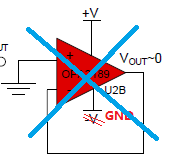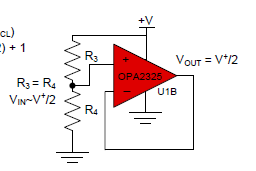Other Parts Discussed in Thread: LM358
Hi Team,
Customer's product uses TLV4171 by using single power supply and there have some unused amps.
Based on TI tech notes, it doesn’t recommend to connect V+ to GND in single power supply, like:

This circuit is properly implemented:

So why the first circuit is not recommended, even though the range of input voltage can be (V-)-0.1 to (V+)-2 in DS? Could you please provide your professional comments? Thanks.
By the way, what is the meaning of "(V-)" and "(V+)"? Is it refer to -2 < (V- + V+)/2 < -0.1? Thanks in advance.

BRs,
Francis



